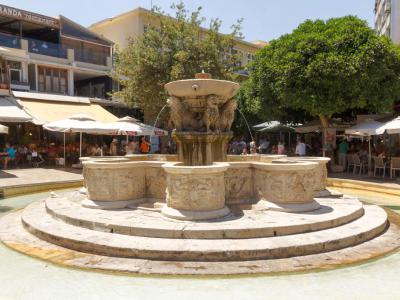Morosini Fountain (Lion's Fountain), Heraklion
The Lions Fountain, also known as the Morosini Fountain, was built to address Heraklion’s water needs while reflecting the city’s Venetian heritage. Completed in 1628 under the supervision of Francesco Morosini and a team of engineers, the fountain provided the city with up to 1,000 barrels of water per day, offering a practical solution to Heraklion’s limited water supply. Its design successfully combined functionality with artistic detail, making it both a utility and a work of craftsmanship.
The fountain is circular with eight lobes, allowing several people to draw water at the same time. At its center, an octagonal pedestal supports four lions, symbols of Venetian authority and strength. Surrounding the pedestal are carved reliefs depicting Greek mythology, including Tritons, dolphins, and nymphs, showing the influence of Renaissance art in Venetian Crete. This careful balance of engineering and decorative detail illustrates the ingenuity and aesthetic priorities of the time.
Throughout its history, the fountain has seen modifications, including additions during the Turkish period, when marble columns were incorporated for ritual washing. A major restoration by the Municipal Council in 1900 returned the fountain to its original form. More recent conservation efforts have uncovered the Venetian underground ducts that channeled water from Archanes to Heraklion, highlighting the advanced engineering behind the fountain’s construction.
Today, the Lions Fountain remains a central feature of Heraklion’s urban landscape. While it no longer serves as the main water source, it continues to attract both locals and visitors who can appreciate its historical, cultural, and technical significance.
The fountain is circular with eight lobes, allowing several people to draw water at the same time. At its center, an octagonal pedestal supports four lions, symbols of Venetian authority and strength. Surrounding the pedestal are carved reliefs depicting Greek mythology, including Tritons, dolphins, and nymphs, showing the influence of Renaissance art in Venetian Crete. This careful balance of engineering and decorative detail illustrates the ingenuity and aesthetic priorities of the time.
Throughout its history, the fountain has seen modifications, including additions during the Turkish period, when marble columns were incorporated for ritual washing. A major restoration by the Municipal Council in 1900 returned the fountain to its original form. More recent conservation efforts have uncovered the Venetian underground ducts that channeled water from Archanes to Heraklion, highlighting the advanced engineering behind the fountain’s construction.
Today, the Lions Fountain remains a central feature of Heraklion’s urban landscape. While it no longer serves as the main water source, it continues to attract both locals and visitors who can appreciate its historical, cultural, and technical significance.
Want to visit this sight? Check out these Self-Guided Walking Tours in Heraklion. Alternatively, you can download the mobile app "GPSmyCity: Walks in 1K+ Cities" from Apple App Store or Google Play Store. The app turns your mobile device to a personal tour guide and it works offline, so no data plan is needed when traveling abroad.
Morosini Fountain (Lion's Fountain) on Map
Sight Name: Morosini Fountain (Lion's Fountain)
Sight Location: Heraklion, Greece (See walking tours in Heraklion)
Sight Type: Attraction/Landmark
Guide(s) Containing This Sight:
Sight Location: Heraklion, Greece (See walking tours in Heraklion)
Sight Type: Attraction/Landmark
Guide(s) Containing This Sight:
Walking Tours in Heraklion, Greece
Create Your Own Walk in Heraklion
Creating your own self-guided walk in Heraklion is easy and fun. Choose the city attractions that you want to see and a walk route map will be created just for you. You can even set your hotel as the start point of the walk.
Heraklion Introduction Walking Tour
Legend tells that Heracles once set foot on Crete to capture the mighty Cretan Bull — a labor that tested both his strength and endurance. From that tale comes the name “Heraklion,” meaning “city of Heracles,” a fitting tribute to a place that has itself endured through centuries of change and conquest.
The area has been inhabited since the Neolithic era, but it first rose to... view more
Tour Duration: 2 Hour(s)
Travel Distance: 2.3 Km or 1.4 Miles
The area has been inhabited since the Neolithic era, but it first rose to... view more
Tour Duration: 2 Hour(s)
Travel Distance: 2.3 Km or 1.4 Miles




